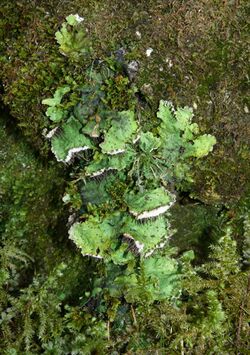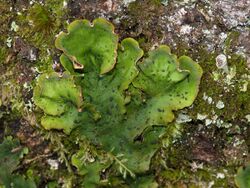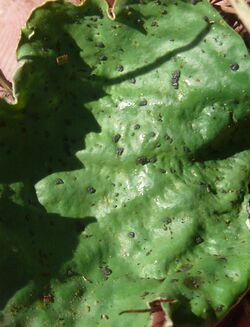Biology:Peltigera
| Peltigera | |
|---|---|

| |
| Peltigera leucophlebia | |
| Scientific classification | |
| Domain: | Eukaryota |
| Kingdom: | Fungi |
| Division: | Ascomycota |
| Class: | Lecanoromycetes |
| Order: | Peltigerales |
| Family: | Peltigeraceae |
| Genus: | Peltigera Willd. (1787) |
| Type species | |
| Peltigera canina (L.) Willd. (1787)
| |
| Synonyms[1] | |
| |
Peltigera is a genus of approximately 100 species of foliose lichens in the family Peltigeraceae.[2] Commonly known as the dog or pelt lichens, species of Peltigera are often terricolous (growing on soil), but can also occur on moss, trees, rocks, and many other substrates in many parts of the world.[3]
Most species of Peltigera have the cyanobacterium Nostoc as the dominant photobiont but some have the algae Coccomyxa. The presence of both a green alga and a cyanobacterium makes some tripartite; in this case they show cephalodium growths containing the third partner, Nostoc. Because of their ability to fix nitrogen from the atmosphere, such lichens are influential in soil composition and generation.
Description
Species of Peltigera are foliose, with broad lobed thalli. Although the size of the thalli is variable and species-dependent, in some species the thalli can grow quite large, up to 30 cm in diameter.[4] The color of the upper surface may range from drab gray, brown or greenish. Lower surfaces are typically without a cortex (unlike other foliose lichens),[5] and cottony, often with fungal hyphae fused to form a network of veins. The reproductive structures isidia, soredia or lobules may be present in some species.[6] All species of Peltigera associate with the nitrogen-fixing cyanobacteria Nostoc.[7][8]
Peltigera can be distinguished from the equally large and leaf-like lichen, Nephroma, by its veined lower cortex; Nephroma, by contrast, has a smooth, unveiled lower cortex.[9]
Habitat
Peltigera are mainly ground-dwelling, but can also be found on mosses or dead wood.[9] Some species are used as forest succession indicators.
Taxonomy
In 1753, Linnaeus first described the species Lichen apthosus and L. caninus back when all known lichens were grouped into the genus Lichen.[10] Later, in 1787, Willdenow circumscribed the genus Peltigera, and redescribed P. aphthosa and P. canina.[11]
The generic name is derived from the Latin language pelta (small shield), and refers to the shield-shaped thallus in these species. The common name, the dog lichen, refers to the perceived resemblance of P. caninus to a dog.[12]
Phylogeny
In a comparative analysis of both morphological and chemical characteristics as well as sequences of large subunit nuclear ribosomal DNA, it was shown that the genus Peltigera is monophyletic.[13] Several species, such as P. canina, have been changed to a group as there appears to be several species clustered under a single name.
Distribution
The Peltigera have a widespread distribution, and are found on all continents. There are 34 North American species, 30 European species, 25 species from South America, and 16 species from New Zealand.[3][4][14][15]
Species
- Peltigera aphthosa (L.) Willd. (1787)
- Peltigera aquatica Miądl. & Lendemer (2014)
- Peltigera britannica (Gyeln.) Holt.-Hartw. & Tønsberg (1983)
- Peltigera canina (L.) Willd. (1787)
- Peltigera castanea Goward, Goffinet & Miądl. (2003)
- Peltigera chionophila Goward & Goffinet (2000)
- Peltigera cinnamomea Goward (1995)
- Peltigera collina (Ach.) Schrad. (1801)
- Peltigera degenii Gyeln. (1927)
- Peltigera didactyla (With.) J.R.Laundon (1984)
- Peltigera dilacerata (Gyeln.) Gyeln. (1932)
- Peltigera dolichorhiza (Nyl.) Nyl. (1888)
- Peltigera elisabethae Gyeln. (1927)
- Peltigera evansiana Gyeln. (1931)
- Peltigera extenuata (Nyl. ex Vain.) Lojka (1886)
- Peltigera fibrilloides (Gyeln.) Vitik. (1998)
- Peltigera fimbriata Vitik., Sérus., Goffinet & Miądl. (2009)
- Peltigera frigida R.Sant. (1944)
- Peltigera gowardii Lendemer & H.E.O'Brien (2011)
- Peltigera granulosa Sérus., Goffinet, Miądl. & Vitik. (2009)
- Peltigera horizontalis (Huds.) Baumg. (1790)
- Peltigera hydrophila W.R.Buck, J.Miadlikowska & N.Magain (2020)
- Peltigera hydrothyria Miądl. & Lutzoni (2000)
- Peltigera hymenina (Ach.) Delise (1830)
- Peltigera isidiophora L.F.Han & S.Y.Guo (2015)
- Peltigera islandica T.Goward & S.S.Manoharan-Basil (2016)
- Peltigera koponenii Sérus., Goffinet, Miądl. & Vitik. (2009)
- Peltigera lactucifolia (With.) J.R.Laundon (1984)
- Peltigera lairdii C.W.Dodge & E.D.Rudolph (1955)
- Peltigera latiloba Holt.-Hartw. (2005)
- Peltigera lepidophora (Vain.) Bitter (1904)
- Peltigera leptoderma Nyl. (1860)
- Peltigera leucophlebia (Nyl.) Gyeln. (1926)
- Peltigera malacea (Ach.) Funck (1827)
- Peltigera membranacea (Ach.) Nyl. (1887)
- Peltigera montis-wilhelmii Sérus., Goffinet, Miądl. & Vitik. (2009)
- Peltigera neckeri Hepp ex Müll.Arg. (1862)
- Peltigera neodegenii L.F.Han, S.Y.Guo & X.M.Xu (2018)
- Peltigera neopolydactyla (Gyeln.) Gyeln. (1932)
- Peltigera neorufescens Goward & Manoharan-Basil (2016)
- Peltigera pacifica Vitik. (1985)
- Peltigera papuana Sérus., Goffinet, Miądl. & Vitik. (2009)
- Peltigera phyllidiosa Goffinet & Miądl. (1999)
- Peltigera polydactylon (Neck.) Hoffm. (1789)
- Peltigera ponojensis Gyeln. (1931)
- Peltigera praetextata (Flörke ex Sommerf.) Zopf (1909)
- Peltigera pulverulenta (Taylor) Nyl. (1860)
- Peltigera pusilla (Fr.) Körb. (1855)
- Peltigera retifoveata Vitik. (1985)
- Peltigera rufescens (Weiss) Humb. (1793)
- Peltigera scabrosa Th.Fr. (1860)
- Peltigera scabrosella Holt.-Hartw. (1988)
- Peltigera seneca Magain, Miądl. & Sérus. (2016)
- Peltigera serusiauxii Magain, Miadl., Goffinet & Ant. Simon (2020)
- Peltigera shennongjiana Han & Guo (2016)[16] – China
- Peltigera sorediifera (Nyl.) Vitik. (2008)
- Peltigera subhorizontalis Gyeln. (1932)
- Peltigera tartarea (Llano) Vitik. (2006)
- Peltigera tereziana Gyeln. (1928)
- Peltigera ulcerata Müll.Arg. (1880)
- Peltigera vainioi Gyeln. (1928)
- Peltigera venosa (L.) Hoffm. (1789)
- Peltigera weberi Sérus., Goffinet, Miądl. & Vitik. (2009)
- Peltigera wulingensis L.F.Han & S.Y.Guo (2013)
Uses
Peltigera species have been used historically to treat wounds, urinary disorders, thrush, tuberculosis, and rabies.[12][17][18] P. apthosa was used as a remedy for cough[19] and infantile aphthae.[20] P. furfuracea has shown potent antioxidant activity and reducing power.[21] Similarly, Peltigera specimens from Hawaii and Iceland have also been reported to show pronounced antioxidant activity.[22]
Food source
Although a few reports have described caribou and reindeer feeding on the thalli of Peltigera,[23] in general, species of Peltigera are not commonly used as a food source by mammals.[24][25] A study of the grazing habits of the land snails Cantareus aspersa and Limax species revealed that these snails prefer to eat Peltigera species (such as P. praetextata) that are lacking in secondary metabolites.[26]
Bioactive compounds
Peltigera leucophlebia contains the compounds tenuiorin and methyl orsellinate, which are inhibitory to the enzyme 15-lipoxygenase.[27] Tenuiorin is also known to occur in P. apthosa, P. malacea and P. neckeri.[28] A mixture of methyl and ethyl orsellinates have been identified from P. aphthosa that had antibacterial activity against Gram-positive and -negative bacteria.[29] The novel non-protein amino acids solorinine and peltigerine have been detected in various species of Peltigera.[30]
References
- ↑ "Synonymy: Peltigera Willd.". Species Fungorum. http://www.speciesfungorum.org/Names/SynSpecies.asp?RecordID=3794.
- ↑ Wijayawardene, Nalin; Hyde, Kevin; Al-Ani, LKT; Dolatabadi, S; Stadler, Marc; Haelewaters, Danny et al. (2020). "Outline of Fungi and fungus-like taxa". Mycosphere 11: 1060–1456. doi:10.5943/mycosphere/11/1/8.
- ↑ 3.0 3.1 "Distribution patterns in the genus Peltigera Willd". The Lichenologist 35 (4): 301–323. 2003. doi:10.1016/S0024-2829(03)00041-0.
- ↑ 4.0 4.1 Vitikainen O. (1994). (1998). Taxonomic notes on neotropical species of Pelitgera. In: Lichenology in Latin America: history, current knowledge and applications. Edited by M. P. Marcelli, and M.R.D. Seaward. CETESB, Companhia de Tecnologia de Saneamento Ambiental, Estado de Sao Paulo. pp. 135-139.
- ↑ Fioliose lichens, Lichen Thallus Types, Allan Silverside
- ↑ Geiser, Linda; McCune, Bruce (1997). Macrolichens of the Pacific Northwest. Corvallis: Oregon State University Press. p. 198. ISBN 0-87071-394-9.
- ↑ "The ecology of Nostoc". Journal of Phycology 31: 2–18. 1995. doi:10.1111/j.0022-3646.1995.00002.x.
- ↑ "Assessing host specialization in symbiotic cyanobacteria associated with four closely related species of the lichen fungus Peltigera". European Journal of Phycology 40 (4): 363–378. 2005. doi:10.1080/09670260500342647.
- ↑ 9.0 9.1 "CNALH - Peltigera". https://lichenportal.org/cnalh/taxa/index.php?taxon=Peltigera.
- ↑ Linnaeus C. (1753). Species plantarum. Stockholm.
- ↑ Willdenow 1787
- ↑ 12.0 12.1 Sharnoff, Stephen; Brodo, Irwin M.; Sharnoff, Sylvia Duran (2001). Lichens of North America. New Haven, Conn: Yale University Press. ISBN 0-300-08249-5.
- ↑ "Phylogenetic classification of peltigeralean fungi (Peltigerales, Ascomycota) based on ribosomal RNA small and large subunits". American Journal of Botany 91 (3): 449–464. 2004. doi:10.3732/ajb.91.3.449. PMID 21653401. http://pdfs.semanticscholar.org/ade6/50e695f3a147e8468be5ee96bc0c7d801f5d.pdf.
- ↑ "Synopsis of the genus Peltigera (lichenized Ascomycetes) in British Columbia, with a key to the North American species". Canadian Journal of Botany 73: 91–111. 1995. doi:10.1139/b95-012.
- ↑ Galloway DJ (2000). "The lichen genus Peltigera (Peltigerales:Ascomycota) in New Zealand". Tuhinga 11: 1–45.
- ↑ Han, Liu-Fu; Yang, Jing-Yuan; Beu, Shu-Qing; Guo, Shou-Yu (2019). "Peltigera shennongjiana, a new cyanolichen from Central China". The Lichenologist 51 (6): 561–574. doi:10.1017/s0024282919000355.
- ↑ "Lichens: the unsung heroes". Amruth 1 (4): 3–6. 1996.
- ↑ Moerman, Daniel E. (1998). Native American ethnobotany. Portland, Or: Timber Press. ISBN 0-88192-453-9.
- ↑ Perez-Llano GA (1944). "Lichens. Their biological and economical significance". Botanical Review 10: 27–40. doi:10.1007/bf02861799.
- ↑ Vartia KO. (1950). On the medicinal use of lichens. Academic dissertation. Helsinki: 11–21.
- ↑ "Antioxidant activity, reducing power and total phenolic content of some lichen species". Fitoterapia 76 (2): 216–9. March 2005. doi:10.1016/j.fitote.2004.05.012. PMID 15752633.
- ↑ "Comparative analysis of the antioxidant properties of Icelandic and Hawaiian lichens". Environmental Microbiology 18 (8): 2319–25. March 2015. doi:10.1111/1462-2920.12850. PMID 25808912.
- ↑ Palmqvist K (2000). "Tansley Review No. 117. Carbon economy in lichens". New Phytologist 148 (1): 11–36. doi:10.1046/j.1469-8137.2000.00732.x. PMID 33863029.
- ↑ "Food habits of the northern flying squirrel (Glaucomys sabrinus) in Oregon". Canadian Journal of Zoology 63 (5): 1084–1088. 1985. doi:10.1139/z85-162.
- ↑ Kallman S (1992). "Wild plants as food during survival situations". Sven Bot Tidsk 86 (2): 49–52.
- ↑ "Differential land snail damage to selected species of the lichen genus Peltigera". Biochemical Systematics and Ecology 32 (2): 127–138. 2004. doi:10.1016/S0305-1978(03)00141-8.
- ↑ "Effects of tenuiorin and methyl orsellinate from the lichen Peltigera leucophlebia on 5-/15-lipoxygenases and proliferation of malignant cell lines in vitro". Phytomedicine 9 (7): 654–658. October 2002. doi:10.1078/094471102321616481. PMID 12487331.
- ↑ Holtan-Hartwig J (1993). "The lichen genus Peltigera exclusive of the P. canina group, in Norway". Sommerfeltia 15: 3–77. doi:10.2478/som-1993-0001.
- ↑ "In vitro evaluation of the antimicrobial activity of lichen metabolites as potential preservatives". Antimicrob. Agents Chemother. 28 (2): 289–92. 1985. doi:10.1128/aac.28.2.289. PMID 3834834.
- ↑ "Distribution of new quaternary ammonium compounds, solorinine and peltigerine, in the peltigerales". Bryologist 102 (2): 196–199. 1999. doi:10.2307/3244359.
Further reading
Gilbert, O. Lichens Naturally Scottish. 2004. Scottish Natural Heritage. ISBN:1-85397-373-4
Wikidata ☰ Q2716168 entry
 |





